Greeting anatomy students, everywhere! Today’s lesson will examine the marvelous, mystical human skull.
Our first lesson about the skeleton was waaay back in Anatomy Lesson #39, Dem Bones – Human Skeleton, but that discussion was pretty general in nature, whereas, the skull alone is quite specific. We do not have sufficient space to cover all details about the skull, so highlights must do.
First, well-earned homage to our fav author, Diana Gabaldon, who wrote this about her life, pre-Outlander:
From the late ’70s to the early ’90s, I wrote anything anybody would pay me for. This ranged from articles on how to clean a longhorn cow’s skull for living-room decoration to manuals on elementary math instruction on the Apple II… to a slew of software reviews and application articles done for the computer press.
Long-horn skulls? Yep. She’s been into head bones for a very long time. 😉
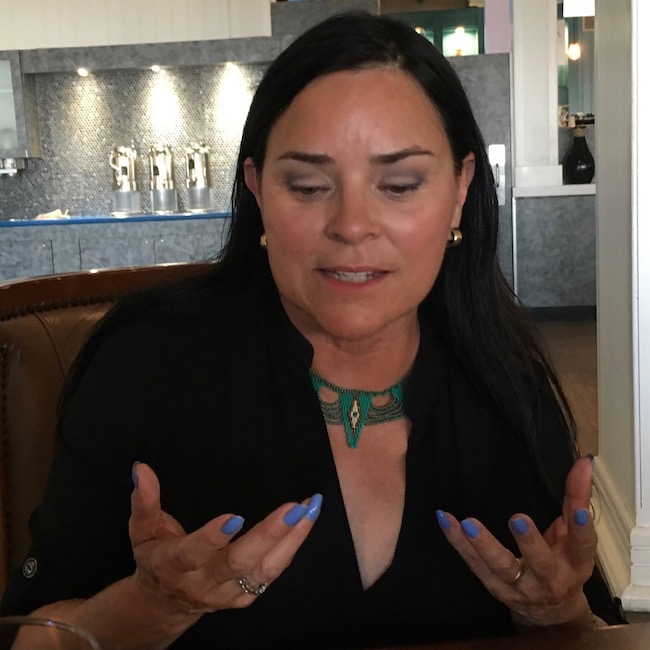
You might not recall, but Outlander has some great scenes involving skulls, so let’s get going!
Beginning with Starz ep 101, Sassenach, a mess of skull stuff happens. Murtagh smartly raps Claire’s skull with his dirk hilt to quiet her. Sorry lass, Redcoats everywhere! And, there’s even more skull stuff:
- Ep 104, The Gathering, Claire wallops Dougal over the heid with a chair
- Ep 104, The Gathering, Rupert whacks Jamie on the skull with his dirk.
- Ep 104, The Gathering, Rupert whacks Jamie on the skull with his fists! (Ep 104 was mighty rough!)
- Ep 108, Both Sides Now, Frank, related to Black Jack, beats thugs’ skulls with his own blackjack!
- Ep 109, The Reckoning, Murtagh thunks a guard on the skull at Fort William.
- Ep 204, La Dame Blanche, Murtagh gets a taste of his own medicine from a secret Paris society bent on violating virgins. Skull dunt!
- Ep 211, Vengeance is Mine, Murtagh separates Duke S. from his skull. Weil, he was asking for it!
- Ep 305, Whisky and Freedom, Dr. Abernathy fondles a pretty lady’s skull in his office. Claire assists. <G>
- Ep 307, Creme de Menthe, With help from Claire’s knife, an excise man’s skull strikes stone!
- Ep 308, First Wife, young Ian is bonked over the heid by pirates!
- Ep 311, Uncharted, Dermestid beetles clean Arabella’s skull!
- Ep 312, Eye of the Storm, Claire relieves Mrs. Abernathy’s body of the weight of her skull!
Doubtless, I have missed a few. Help me out here, anatomy students!
Update! A student reminded me of the cave scene wherein Geillis shoots Jamie in the head. The pistol ball travels under his scalp to end up in the back of his head (occipital region). Claire removes it with a blade. The ball failed to penetrate Jamie’s skull because Geillis had failed to load the pistol with sufficient charge. Thank you, Marguerite!
This is the quote from Voyager book. Sadly, it wasn’t filmed so no image to accompany this splendid description:
… I sat Jamie down with a pan of water, to tend the damage to his head. I washed away the blood from face and hair, to find to my surprise that the ball had in fact not plowed a furrow through his scalp as I had thought. Instead, it had pierced the skin just above his hairline and—evidently—vanished into his head. There was no sign of an exit wound. Unnerved by this, I prodded his scalp with increasing agitation, until a sudden cry from the patient announced that I had discovered the bullet. There was a large, tender lump on the back of his head. The pistol ball had traveled under the skin, skimming the curve of his skull, and come to rest just over his occiput.
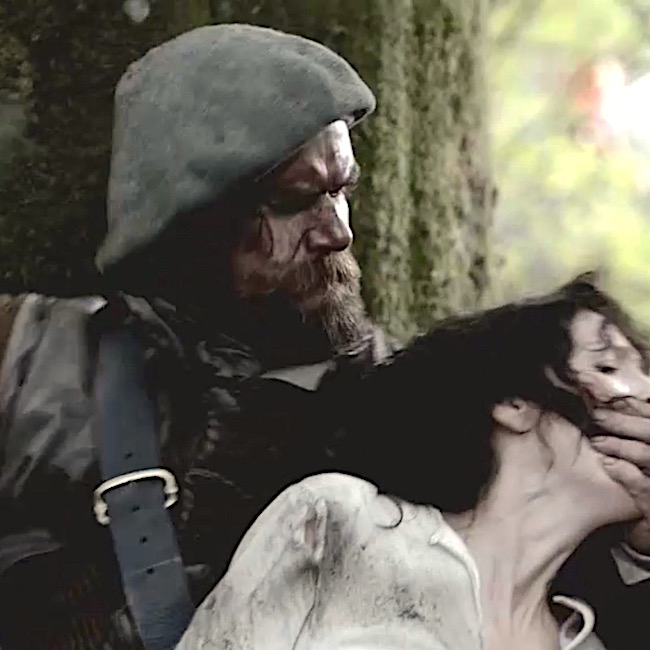
I usually resist descending into the macabre, but let’s introduce the skull with this tidbit. In 2016, 454 human skulls (Image A) were offered for sale on eBay with opening bids ranging from one cent to $5,500! Sources of the skulls were unknown. Since then, eBay has revised its policy to “ban the sale of all human body parts except hair.” Thumbs up! Without informed consent, the sale of body parts is rife with ethical issues.
As a former Director of the body donation program at my medical university, sales of human parts for non-scientific purposes were deemed unethical – a sound policy.
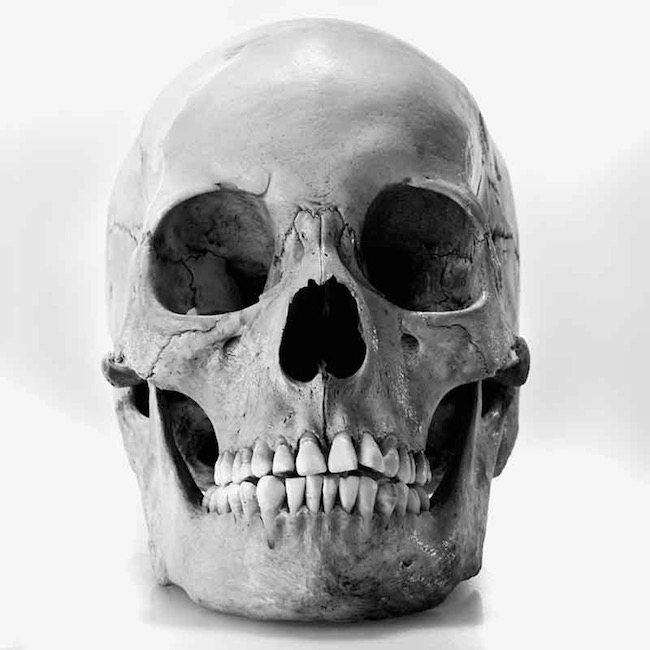
Image A
Definitions: Best to begin our lesson with definitions.
The English word “skull” is likely derived from Old Norse “skulle”, whereas the Latin word cranium comes from the Greek root κρανίον (kranion). What do these words mean?
- Skull – all bones of head including mandible (lower jaw). Teeth are not included because they are not bones.
- Cranium ( see Image B) – all skull bones (colors) excluding the mandible (white)
- Neurocranium – cranial bones that encase the brain
- Viscerocranium – facial bones
Function:
Q: Why are skulls so important?
A: Because, skulls are critical elements of the human skeleton which serve to protect the brain and house these major sensory organs:
- Inner ear for hearing & balance – (Anatomy Lesson #25, If a Tree Falls – The Ear)
- Nose for olfaction – (Anatomy Lesson #28, Savvy Sniffer – Claire’s Nose Knows!)
- Eyes for vision – retina (Anatomy Lesson #33, EyeMax – The Eye, Part 5)
- Tongue for taste buds (Anatomy Lesson #44, Terrific Tunnel – GI System, Part 1)
The skull also fixes the distance between the eyes to allow for stereoscopic vision (depth perception), and positions the ears to enable us to localize direction and distance of sounds.
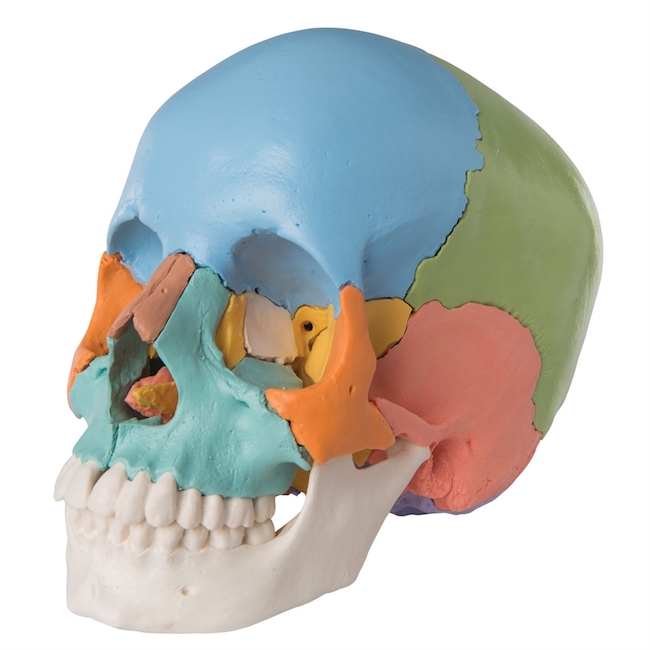
Image B
Pause for another deep breath of Outlander! Whisking us into the ‘little shop of horrors” run by conjurer Master Raymond (Starz, ep 204, La Dame Blanche), Claire beholds strange sights. Filled with oddities and ancient bones, curios include the skull of a unicorn! What???? He, he. There it is, with its own shaffron (head armor) complete with a hole for the horn. Only fitting to pay respect to Scotland’s National Animal. Clever!
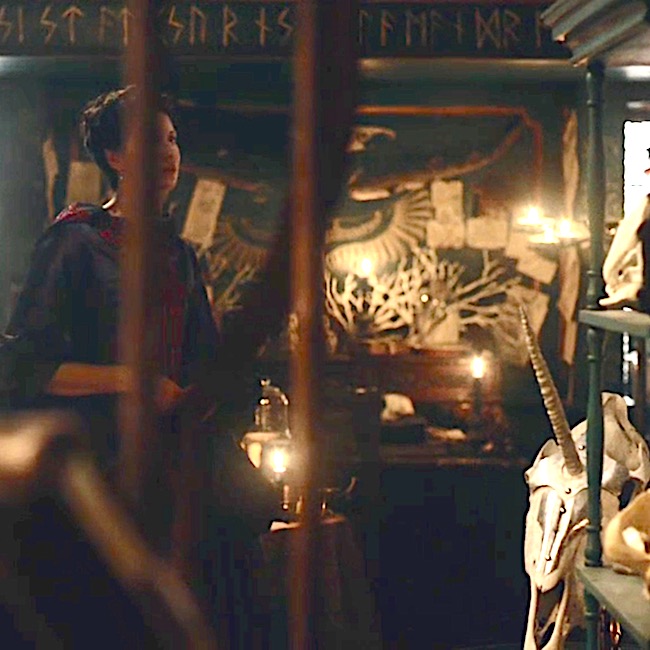
Back to the anatomy grind…..
Skull Development: The human skull passes through amazing transformations during development. At birth, the skull is made of 44 different bony elements and the facial skeleton is 1/7 the size of the calvaria (Image C). In other words, big head – small face.
As bony elements fuse, open areas persist; these are the fontanelles (6 of them). With further age, skull bones fuse into unmovable joints known sutures – only the mandible retains a pair of moveable joints throughout life. Some sutures contain little islands of bone. Collectively known as wormian bones, these are inconsistent features of the human skull.
Psssst…No cause to fash about this wee skull; it is a plastic model.
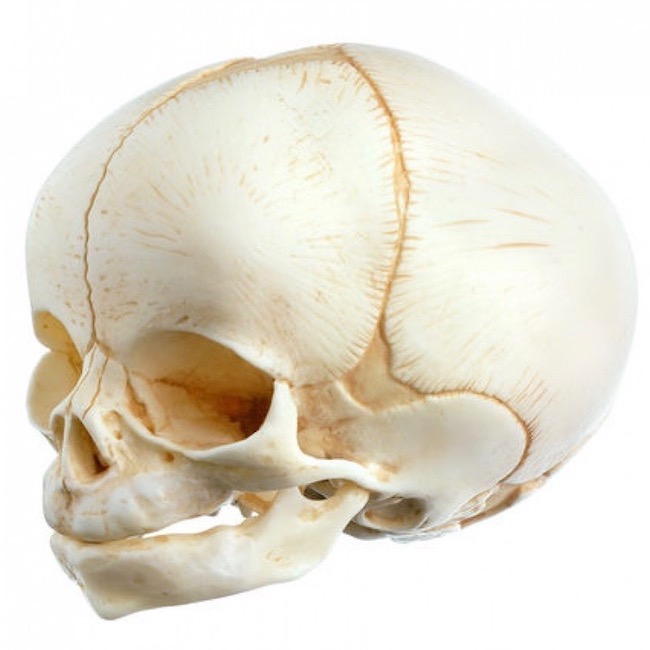
Image C
Adult Skull: Once fusion is complete, the adult skull has 22 or 28 bones depending on how they are counted (anatomists differ on this): 28, if ear ossicles (Anatomy Lesson #25, If a Tree Falls – The Ear) are included in the count or 22, if they are not. And, the adult facial skeleton is 1/2 the size of the calvaria, meaning with age, facial bones grow more than cranial bones. Wormian bones are not included in a skull bone count because they are inconsistent features. Remember? Good!
Wow! Image D shows an adult skull which has been “exploded,” exposing its component bones. This view affords an appreciation of the skull and its many varied and complex parts. Such preparations are very expensive but, nonetheless, are rather common exhibits in anatomy labs. Typically, these are encased in glass and unavailable for handling because several bones are paper-thin. Look but do not touch!
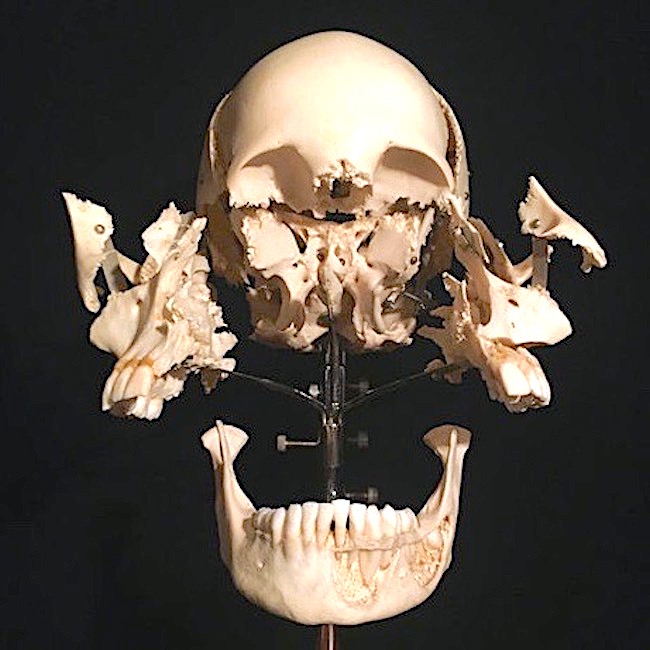
Image D
Here are the odd names of the skull bones (Image E):
- occipital (1) – royal blue
- temporal (2) – orange
- parietal (2) – turquoise
- sphenoid (1) – red
- ethmoid (1) pink
- frontal (1) – lime green
- nasal (2) – lavender
- lacrimal (2) – lavender (guess they ran out of colors?)
- zygomatic (2) – yellow
- maxillae (2) – purple
- mandible (1) – dark green
- vomer (1) – peach (part of nasal septum)
- inferior turbinate (2) – yellow (sides of nasal cavities)
- palatine (2) – not shown (part of roof of mouth)
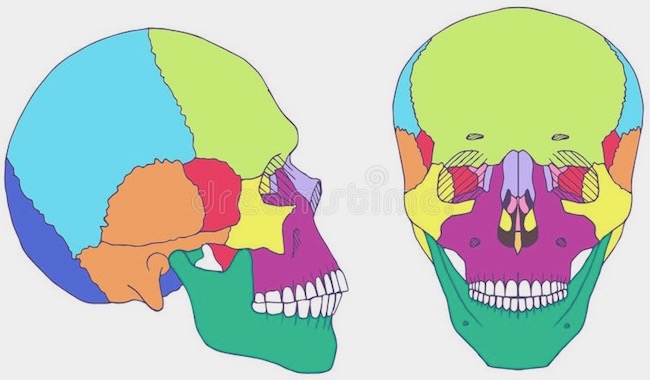
Image E
Another dram of Outlander!
Ever ponder how skulls end up so clean? Anatomical preparers typically utilize insects to do the job. Dermestid beetles are splendid at this icky task and, believe it or not, they are fastidious eaters because they prefer to dine only on carrion! These beasties can even be purchased on line. Or, if beetles don’t suit you, hydrogen peroxide and baking soda are home remedies for an animal skull which demands a thorough cleaning.
Therefore, Outlander accurately depicts Father Fogden using beetles to clean and preserve beloved Arabella’s skull (Starz episode 311, Uncharted). Talk about gross anatomy. Total yuck!!!
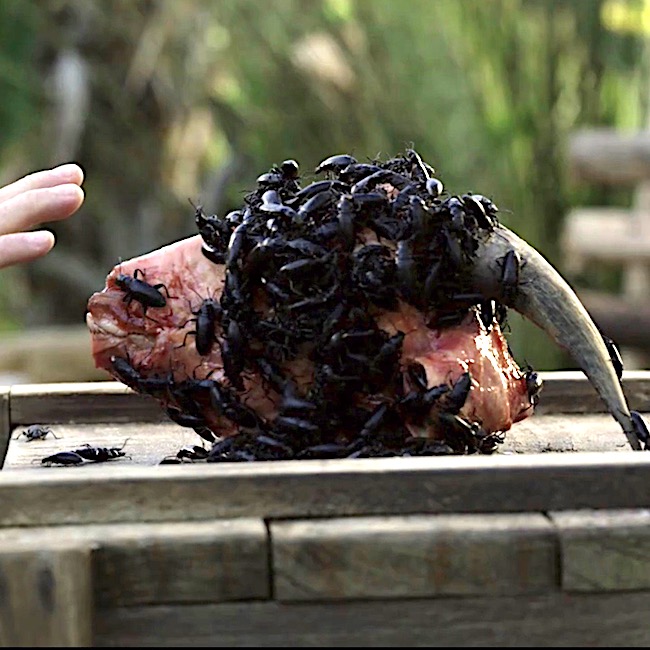
If you really wish to see the process in a scientific setting, this is a good YouTube video. But, I advise you to skip, if you are squeamish.
Neurocranium: A few tidbits about the neurocranium. This part of the skull is commonly known as the braincase because it forms a bony hollow housing the brain (Image F). It is composed of all skull bones except mandible and facial bones. It is like a rounded cubical with ceiling, floor, front, back and sides. The shape is a perfect fit providing solid support for soft brain tissue. Got it? Yay!
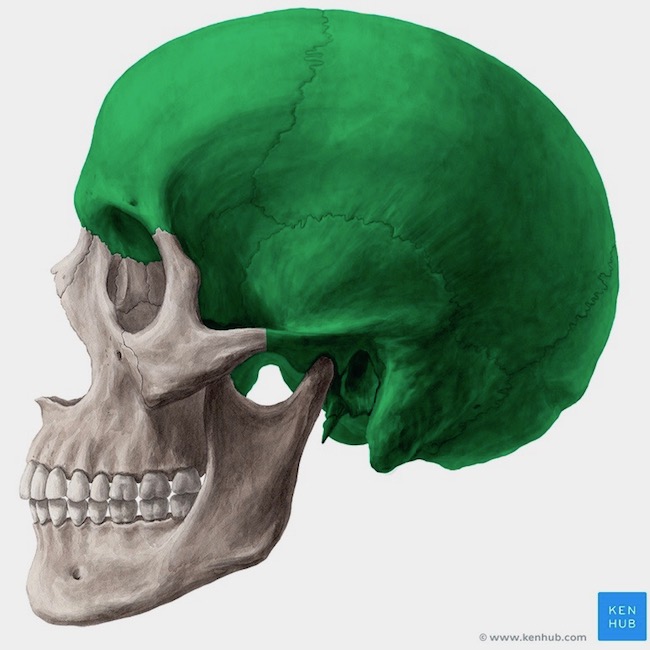
Image F
Flat Bones: Bones of the neurocranium come in weird shapes. Some, such as frontal, parietal and part of temporal are thin, flat bones. Flat bones are fascinating because they are curved (go figure, <g>) with outer and inner layers of compact bone sandwiching a core of spongy bone. In image G, the top layer of dense bone is the outer surface, adjacent to the scalp; the bottom layer is closest to the brain. Each compact bony layer is known as a table, so there are outer and inner tables. The spongy core, known as diploe, isn’t spongy at all (go figure, <G>). But, it sure looks spongy. Rather, diploe is a delicate network of bone riddled with holes. In life, the holes aren’t empty; they are filled with blood vessels, developing blood cells and fat cells. Hence, the term “fat heid.” Ha, ha – just kidding!
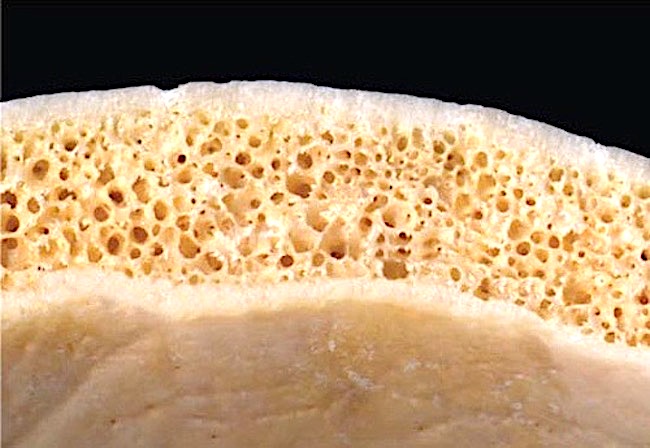
Image G
Foramina: Another interesting feature – the skull is full of holes (Image H)! Known as foramina (sing. foramen), the holes traverse the skull from outside in or inside out depending on your point of view. Such openings vary from pinpoint size to the largest, the foramen magnum (2.5 – 3.4 cm), at the skull base.
Foramina are ports for the passage of blood vessels and nerves between inside and outside the skull. Foramen magnum is traversed by the spinal cord as it descends to enter the vertebral canal (Anatomy Lesson #10, Jamie’s Back or Aye, Jamie’s Back!).
Try This: Bring palms together with thumbs extended toward the face. Place thumb pads against the eyebrows and move the pads back and forth a bit. They should settle into a pair of divots or depressions. These are the supraorbital notches/foramina through which pass the supraorbital (sensory) nerves. You have just demonstrated the method by which these nerves leave the skull and reach the face. Hurrah!
.
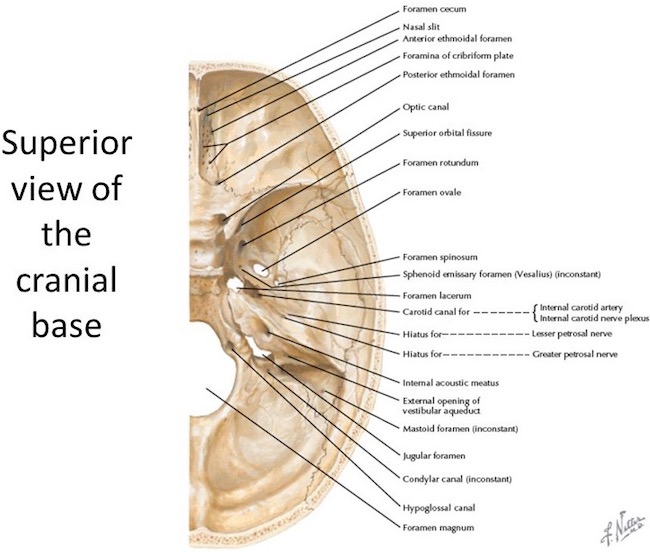
Image H
Meningeal Arteries: The brain, nestled inside the neurocranium, is surrounded by three layers of membranes, the meninges. The outermost meninx (sing.), known as dura mater (Latin meaning tough mother), contains several meningeal arteries which supply blood to the dura and adjacent skull. Scroll back to Image H and locate grooves on the inner surface of the bottom table. These imprints are caused by meningeal arteries pressing into the bone.
One such vessel is the middle meningeal artery. This important artery is located deep to the temple region where four neurocranial bones meet at the pterion (Image I). Here, the bones are very thin.
Now, because the brain is encased in bone, one might expected it to be impervious to harm, but if so, one would be wrong. A blow, fall or other accident (such as a golf ball to the temple) can burst the middle meningeal artery causing blood to accumulate between the dura and inner bony table, an injury known as an epidural hematoma (a clot between skull and dura mater). The accumulation of blood puts pressure on the brain and interferes with neural function.
This type of brain injury is usually accompanied by loss of consciousness, brief regaining of consciousness, followed by another loss of consciousness. Confusion is typical; bleeding from the ear may occur. Treatment requires immediate surgery, a craniotomy. Without treatment, death typically ensues.
So, can you surmise where this lesson is headed? Of course you can!
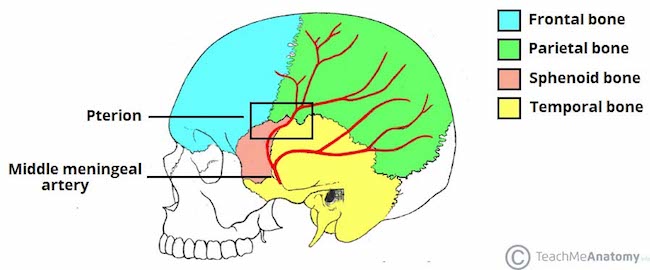
Image I
OK, now let’s see how anatomy applies to Outlander!
Incise the Excise Man: John Barton, a nasty tax man working for the corrupt Sir Percival, attacks Claire in Jamie’s brothel-nest (Starz ep 307, Creme de Menthe). During his battle with Dr. Dura Mater, she stabs his leg and he falls striking his left temple on the stone hearth. Blood drains from his left ear and Claire (sans modern imaging techniques) quickly diagnosis an epidural hematoma!
Soon, she acquires a trephine (barber surgeons in Edinburgh would likely have these), in essence, a hand drill. She incises the skin over John’s left temple, positions the trephine and proceeds to drill for oil!
Now, drilling through skull bones of the pterion region means the bit must pass through outer table, diploe and inner table of said bones. The good Doctor detects a slight give as the drill completes the traverse. Then, (and, this was thrilling to me!) Claire correctly backs the drill out by reversing direction of the drill handle and voila, a burr hole! What a braw lassie!
Now, blood can drain from the injury giving John a chance at survival. Unfortunately, or fortunately if you belong to team Jamie, he does not. He would surely have died without the surgery, but he died with it, anyway. Warrior Claire fought valiantly for her patient in her own battle joined, but to no avail.
Understand that trephination/trepanation is not a new surgical technique as burr holes been found in prehistoric human remains. In ancient times, holes were drilled into a person’s skull, it is thought, to release evil spirits. BJR surely could have used one! Or how about Geillis?
So, armed with the science of anatomy, we now understand the nitty gritty of what took John Barton’s life! Don’t you feel ever so much wiser?
Today, a craniotomy is performed to release the pressure from an epidural hematoma and other types of brain injuries. Although more sophisticated, it works similarly to a trephination. In an abbreviated explanation, 3-4 burr holes are drilled through the skull and connected by saw. The piece of skull, or bone flap, is freed. The hematoma (blood clot) is usually suctioned out, the bony segment replaced and the scalp secured in place.
If you aren’t squeamish, this video shows an excellent demo of a craniotomy for epidural hematoma:
And, Claire’s version:
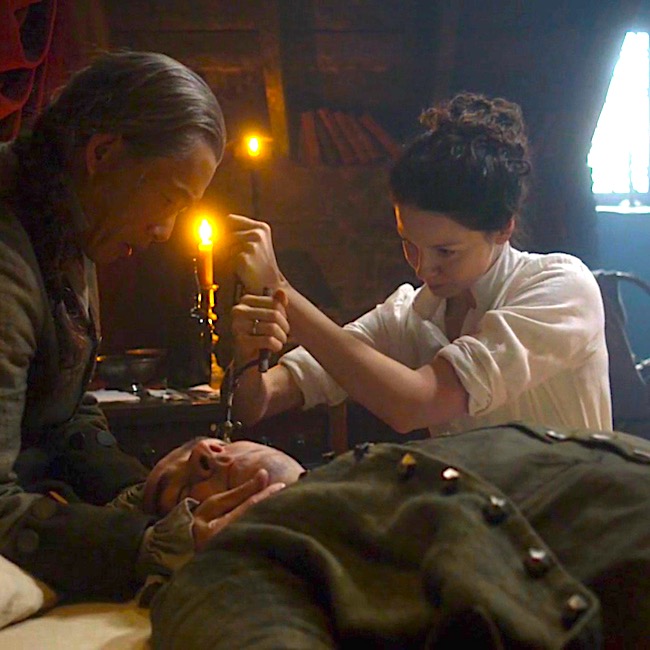
Now, lest you depart this lesson thinking the Outlander trepanation/trephination is a total fabrication by the series writers, it isn’t. Diana wrote about trephination in Drums of Autumn. Yes, she did. This woman leaves no stone unturned!
Here is the quote (there is another in An Echo in the bone), but to prevent spoilers, the name of the patient is withheld and another name is blocked out, otherwise the quote is intact:
She was thinner than he remembered, though it was hard to judge of her figure, dressed as she was in a barbaric leather shirt and trouserings. She’d plainly been in the sun and weather for some time; her face and hands had baked a delicate soft brown, that made the big golden eyes that much more startling when they turned full on one—which they now did.
“ ———-says that Dr. Fentiman trephined your skull.” He shifted uncomfortably under the sheets. “I am told that he did. I am afraid I was not aware of it at the time.” Her mouth quirked slightly. “Just as well. Would you mind if I look at it? It’s only curiosity,” she went on, with unaccustomed delicacy. “Not medical necessity. It’s only that I’ve never seen a trepanation.” He closed his eyes, giving up. “Beyond the state of my bowels, I have no secrets from you, madame.” He tilted his head, indicating the location of the hole in his head, and felt her cool fingers slide under the bandage, lifting the gauze and allowing a breath of air to soothe his hot head.
Now, let’s close this lesson with a feeling of satisfaction for knowledge gained and with an appreciation of skull art. The following three images show an intricate and creative carving of a human skull. I do appreciate the skill although I remain ambivalent about using human skulls in this manner. And, it is a human skull. I enlarged the images and diploe is clearly visible at some of the cut surfaces. Plastic models don’t exhibit spongy bone in their construct.
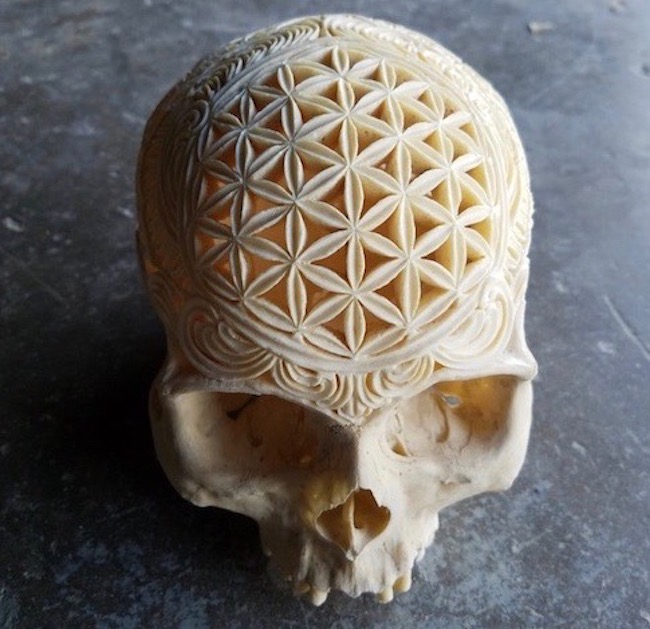
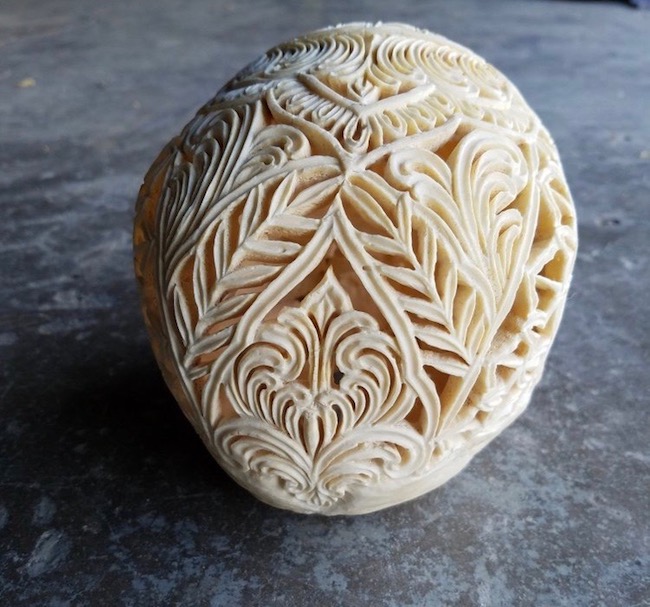
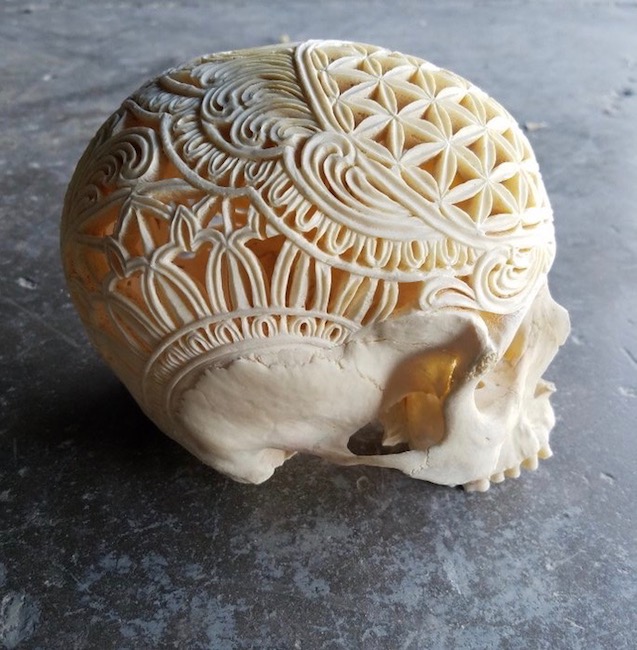
Let’s close with the lyrics of “It’s a Lie,” by the rock band, Fiction Plane:
Underneath my face there is a human skull
Without the living flesh you’d find it pretty dull
Ah, no. With all due respect, I disagree! The skull is a fascinating part of the human anatomy. Fiction Plane guys, read the lesson! <G>
The deeply grateful,
Outlander Anatomist
Follow me on:
- Twitter @OutLandAnatomy
- Join my Facebook Group: OutlandishAnatomyLessons
- Instagram: @outlanderanatomy
- Tumblr: @outlanderanatomy
- Youtube: Outlander Anatomy
Photo Credits: Sony/Starz; Diana Gabaldon photo, personal collection of Outlander Anatomy; www.3b.scientific.com (Image B); ewww.dreamtime.com (Image E); www.holtanatomical.com (Image C); www.kenhub.com (Image F); www.newscientist.com (Image A); www.news.psu.edu (Image G); https://rachelleeart.bigcartel.com; www.slideplayer.com (Image H); www.teachmeanatomy.com (Image I); www.thehuntnyc.com (Image D)

“As a former Director of the body donation program at my medical university, sale of human parts for non-scientific purposes were deemed unethical – a sound policy.”
I like that I know more about you and your anatomy history. I’ve always believed everything you say but now- You are a Goddess!!!!!
Hi roseann:
Thank you for writing! I am glad that my comment was reassuring to you. The program was very stringent about the use of human bodies, especially because they were gifts from people who willed their remains to us. At the end of each course, we held a memorial service honoring the gifts. Friends and families were invited. The medical students organized the event and they sang songs, read poetry, and wrote stories of their experience. All this was for the families and there was nary a dry eye in the auditorium. We were one of the first programs in the US to do this and I was so proud of them. A little more: I directed gross anatomy courses, directed the body donation program and was the demonstrator of anatomy for my home state of Oregon. I held these positions for many years. Your goddess comment made me grin. One year, my medical students gave me a new lab coat embroidered with the label: anatomy goddess. I still have it and as you might imagine it is very precious to me. Again, TY so much!